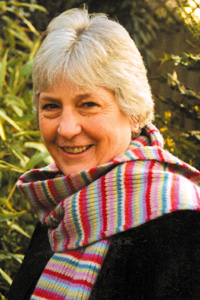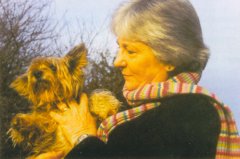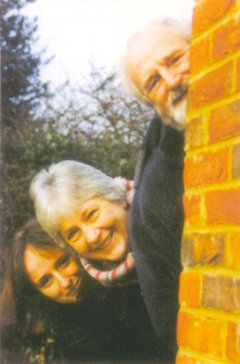Originally published in March 2003 icon
Thyroid Cancer - The Facts

Beating Thyroid Cancer
Julie Willis has overcome thyroid cancer with a combination of surgery, radioactive iodine treatment and prayer.
The calm, softly-spoken 53-year-old is married to an Anglican priest, has started training to be a lay minister, and is already a grandmother twice over, with a third grandchild on the way.
She had a benign pituitary tumour removed, more than 20 years ago, after years of misdiagnosis and worry.
But when she was diagnosed with thyroid cancer four years ago she felt "at peace" with the whole procedure.
Now working as an administrative assistant at the Lymphoma Association, Julie was so impressed with icon’s positive approach to cancer that she has decided to tell her story to show others how "painless" treatment can be.
Here’s Julie’s story in her own words...

I want everyone to know that it’s very treatable

"I was in the kitchen doing the washing up, with my husband, Tony, when I felt it. A small pea-sized soft lump on the right side of my neck. I’d never noticed it before, and it didn’t show when I looked in the mirror. I wasn’t worried because it didn’t hurt, and you’re not told to check your neck for lumps, are you?
My youngest daughter Claire, now 30, had had swollen glands lots of times, and I thought that’s what I had when I went along to see my doctor about a week or so later. I was told to keep an eye on the lump and come back in two weeks, if it was still there. It was, and I went back several times at fortnightly intervals, seeing various GPs at our local health centre, throughout the summer of 1998.
The lump didn’t get any bigger, but it didn’t go away, and eventually one of the doctors suggested doing a blood test. When I went back for the results she said brightly, ’If you think you’ve got cancer, you’ve got nothing to worry about.’ I hadn’t even considered cancer. I’d assumed it was just a lump of fatty tissue.
A few weeks later I found myself chatting to a lady in our church, who’d had surgery on her neck for a cancerous growth. ’i’ve got a lump,’ I said, ’but the doctors say it’s OK.’ She told me that I must go back and ask for a biopsy. I did and was referred to Stoke Mandeville Hospital, where day surgery was arranged for 29 September 1998. I dread to think what would have happened if I hadn’t chatted to that lady...
I had the lump removed and went back 10 days later, with Tony, for the results, totally expecting to be told that it was a cyst. I was very surprised when the receptionist gave me an appointment card as I checked in. The doctor said he had bad news and good news. The bad news was that the lump, removed from the lymph gland in my neck, was malignant and the cancer had spread from my thyroid gland. The good news was that it was very treatable.

I was in shock because I’d convinced myself it was nothing

I couldn’t believe what he was saying. I was in shock because I’d convinced myself it was nothing. I didn’t feel ill at all, and had no other symptoms. I sat there numb, as another doctor described the black lump he’d removed and they discussed removing my thyroid gland. I was fine in the room, but remember crying on the way out of the hospital with Tony comforting me. I was so upset, but hung on to the words that ’it was very treatable’ and ’would be OK’. The first thing I did when I got home was throw away my medical encyclopaedia, because I didn’t want to know too much about my condition.
I didn’t go back to Stoke Mandeville Hospital, because the following day Tony rang the consultant I see regularly in Oxford (I had surgery to remove a benign pituitary tumour in 1981 and require ongoing hormone replacement) and he arranged for me to see a surgeon at the John Radcliffe Hospital on Monday. While Tony did that I’d gone back to work, at RAF Halton, and kept myself busy.
When I went to Oxford, the surgeon explained that he’d do a total thyroidectomy, followed by radioactive iodine treatment The operation was booked for three weeks’ time, 2 November. While I was waiting I did read up a bit about thyroid cancer in the BMA’s ’Understanding Thyroid Disorders’. There’s a chapter on it that’s quite positive, and that was all the information I needed at that time. I also tried creative visualisation. Because someone described the thyroid as a butterfly shape in my neck, I’d tell the bad butterfly to fly away and would imagine it going.

I did read up a bit about thyroid cancer and that was all the information I needed at that time

I also arranged for a vicar, Bill, from a nearby parish to come and pray in my house. Although my husband said prayers for me in church, I felt he was too close to do these prayers. Tony, Nicky and a few friends were there as Bill laid hands on me, anointed my forehead with oil and prayed for healing, peace and strength. From that time on I had peace and experienced no fear whatsoever throughout the whole period of treatment. I felt sure inside that it would be OK and this was what I told my daughters and family.
I was in hospital for four days, because I was on a course of hydrocortisone injections for my hypopituitarism, and, apart from vomiting through the night after the anaesthetic, I felt no discomfort at all. The next morning I was up, showered and with a bit of make-up on when Tony and Nicky came to see me. They were quite surprised at how well I looked. I had all these clips around my neck, like a necklace, but when it was all taken off there was hardly a scar. The surgeon did really well.
I had about three weeks off before going back to work. I was already on thyroid replacement, as my thyroid wasn’t functioning due to the pituitary problem, but have always been told the two illnesses are not related.

I put my entire trust in my consultant in Oxford because I’ve been seeing him since 1995 and he’s different to any other consultant I’ve ever seen. He’s always been very concerned with the whole person - not just the area he’s treating.
I was admitted to the Frank Ellis unit of the Churchill Hospital on 4 January 1999 for the radioactive iodine treatment. I’d had a letter preparing me for what was in store, but was still apprehensive about being shut away on my own for four days, as I’m a bit claustrophobic. But it was alright. The door was left open so, although no one could come in, past a line, my family could see me and I could hear what was going on in the next ward, which made all the difference.
I took the iodine capsule on the first day. It was quite sinister really because the radiographers came in, wearing protective clothing and pushing a trolley with a canister on it. They didn’t touch anything. I had to take the tube, containing the capsule, out and then swallow it before putting everything back. It was weird that they were all gowned up and protected from something that I had to swallow.
Everything in the room was covered with plastic. The floor, TV~ even the door handles wore rubber gloves! I had to bring old night clothes with me, which had to be left there and destroyed because iodine is excreted in perspiration. For that reason I also showered twice a day. I just relaxed, watched TV, read and felt absolutely fine.
When it was time to leave, I had to leave my book and magazines there, but was allowed to bring out some of my make-up containers, which I’d washed. They checked everything for radioactivity before I left.

I don’t regret what’s happened at all

Three weeks later I had a follow-up weaker dose of iodine, which I drank, as an outpatient, and that was it. I had a scan after each treatment, which was fine and I go for an annual check-up. Follow up consists of coming off thyroid replacement and having a blood test to see if there is any thyroglobulin in the blood. If there is, further treatment may be necessary. My next check is in March, but it doesn’t worry me.
Strangely the worst bit came when all the treatment was finished and the cancer had gone. Since starting work at the Lymphoma Association, I’ve heard that this often happens. While you’re centre of attention, and everyone is worrying about you, you stay strong for their sake, and then afterwards people think you are fine and that’s when you can go through a period of depression. Mine used to hit me in church. I was fine at work, but anything could trigger me off during a service and I’d start crying. My husband found it quite difficult to deal with. He’d heard the doctor say it would OK, and I was cured, so why was I having problems? I wasn’t worried the cancer would come back, I just felt a bit sidelined.

A new project had started in the three parishes Tony looks after, while I’d been ill, and I wasn’t involved in it. People didn’t want to talk about what had happened to me, and sometimes - and I’ve found this since with friends who’ve had cancer - all you want to do is talk about it.
My daughter Nicky is very good to talk to, but I also had counselling and was on antidepressants for more than a year, both of which helped me get back to normal. Now I’m fine and enjoying life and work. If it had been a century ago, I probably wouldn’t be alive now so I’m grateful for that.
My faith has helped me throughout. Being able to offload it all onto someone else, and trusting that God was in control, not me, helped me through my treatment.
I don’t regret what’s happened at all. It has changed my outlook on life, and I feel that if I can help people avoid a negative, frightening experience that’s what I’m keen to do. If anyone diagnosed with thyroid cancer is reading this, I want them to know that there’s no pain attached to it at all, very little discomfort and, most importantly, it can be treated."